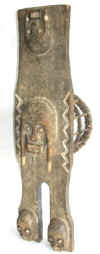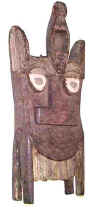TRIBAL AFRICAN ART
IJO (IJAW)
Nigeria
Numbering 200,000 to
350,000, the Ijo people live mainly in the creeks and mangrove swamps of the Niger Delta
area. Being fishermen and traders they depend upon the water for food and communication.
The Ijo are divided into two groups: the Kalabari-Ijo, east of the Nun River, and the
western or central Ijo, who live to the west and northwest of this river. The art of both
groups is characterized by a schematized approach, whereby most works of the central Ijo
evince a higher degree of stylization and abstraction than those done in the Kalabari
regional style. Yet also found in the western area are more realistic masks in the form of
fish or animals, which are worn on the forehead. However, the best known forehead masks of
the central Ijo, which embody water spirits (owuamapu),
contain depictions of human heads built up of geometric shapes and combined with
zoomorphic or abstract elements. Besides ancestors and deceased local heroes, water
spirits play an important role in the religious ideas of the Ijo. They believe that these
spirits are like humans in terms of their strengths and weaknesses and that before their
birth, human beings live among them. Once born, the Ijo maintain contact with them through
prayers in order to gain their favors.
Celebrations
in honor of the water spirits lasting several days are held annually, either at the
beginning of the year or the time of high water, in order to gain the spirits’
goodwill and insure the group’s welfare. In the course of festivities various
masqueraders embodying the water spirits perform, and the presence of the spirits, by whom
they feel possessed, is manifested in the intensity of their dancing. The Ijo masks for
the cults of the water spirits are made in the form of aquatic animals, especially
hippopotamus and crocodiles.
The
western Ijo use the figures, in which the
head of the household is represented upon a highly schematic quadruped that is said to
represent the guardian spirit of the family. Among the eastern Ijo, shrines for the water
spirits have figures that are often large though frequently kept hidden. They also have
masks, similar to those of the western Ijo, worn by men of the Ekine society. In
addition, there are shrines that contain sculptures for the village heroes and ancestors.
In some Kalabari communities, rectangular screens are fashioned by carpentry into a
low-relief frontal group in which a commemorated ancestor is flanked by supporting
figures. All Ijo sculpture exhibits a four-square schematic style that contrasts starkly
with the relative naturalism of surrounding styles, such as those of Yorubaland or Benin.
Visit our
Museum Store
Learn more about
Ijo

